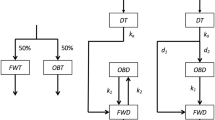Abstract
The distribution and excretion of a single tracer dose of cadmium-109 given intravenously to rats were studied in a 60-day time course experiment. The organs that accumulated the most cadmium were the liver, kidneys, and pancreas. Initial high plasma levels decreased rapidly, and most of the cadmium that remained in the blood after 24 hr was found in the red cells. In most organs and tissues a level was reached within 24 hr at which the cadmium concentration remained relatively stable. Kidney was a marked exception because the amount of cadmium found in that organ increased progressively. Excretion of cadmium was found to be predominantlyvia the feces. Twenty-five to 28% of the dose was excreted by that route in 60 days, the most rapid phase occurring during the first three days. Less than 0.15% of the dose was excretedvia the urine.
Similar content being viewed by others
References
Decker, C. F., R. U. Byerrum, and C. A. Hoppert: A study of the distribution and retention of cadmium-115 in albino rats. Arch. Biochem. Biophys.66, 140 (1957).
Dittmer, D. (ed.): Blood and Other Body Fluids, Federation of the American Society of Experimental Biology, Washington, D.C. (1961).
Friberg, L., M. Piscator, and G. Nordberg: Cadmium in the Environment. Cleveland, Ohio: CRC Press (1971).
Gunn, S. A., and T. C. Gould: Selective accumulation of Cd115 by cortex of rat kidney. Proc. Soc. Exp. Biol. Med.96, 820 (1957).
Johnson, A. D., and W. J. Miller: Early actions of cadmium in the rat and domestic fowl testis. II. Distribution of injected109cadmium. J. Reprod. Fertil.21, 385 (1970).
Lucis, O. J., and R. Lucis: Distribution of cadmium 109 and zinc 65 in mice of inbred strains. Arch. Environ. Health19, 334 (1969).
Lucis, O. J., M. E. Lynk, and R. Lucis: Turnover of cadmium 109 in rats. Arch Environ. Health18, 307 (1969).
Moore, W., jr., J. F. Stara, and W. C. Crocker: Gastrointestinal absorption of different compounds of115mcadmium and the effect of different concentrations in the rat. Environ. Res.6, 159 (1973).
Schroeder, H. A., and J. J. Balassa: Abnormal trace metals in man: cadmium. J. Chron. Dis.14, 236 (1961).
Shaikh, Z. A., and O. J. Lucis: Cadmium and zinc binding in mammalian liver and kidneys. Arch. Environ. Health24, 419 (1972).
Author information
Authors and Affiliations
Rights and permissions
About this article
Cite this article
Horner, D.B., Smith, J.C. The distribution of tracer doses of cadmium in the normal rat. Arch. Environ. Contam. Toxicol. 3, 307–318 (1975). https://doi.org/10.1007/BF02220743
Received:
Accepted:
Issue Date:
DOI: https://doi.org/10.1007/BF02220743




